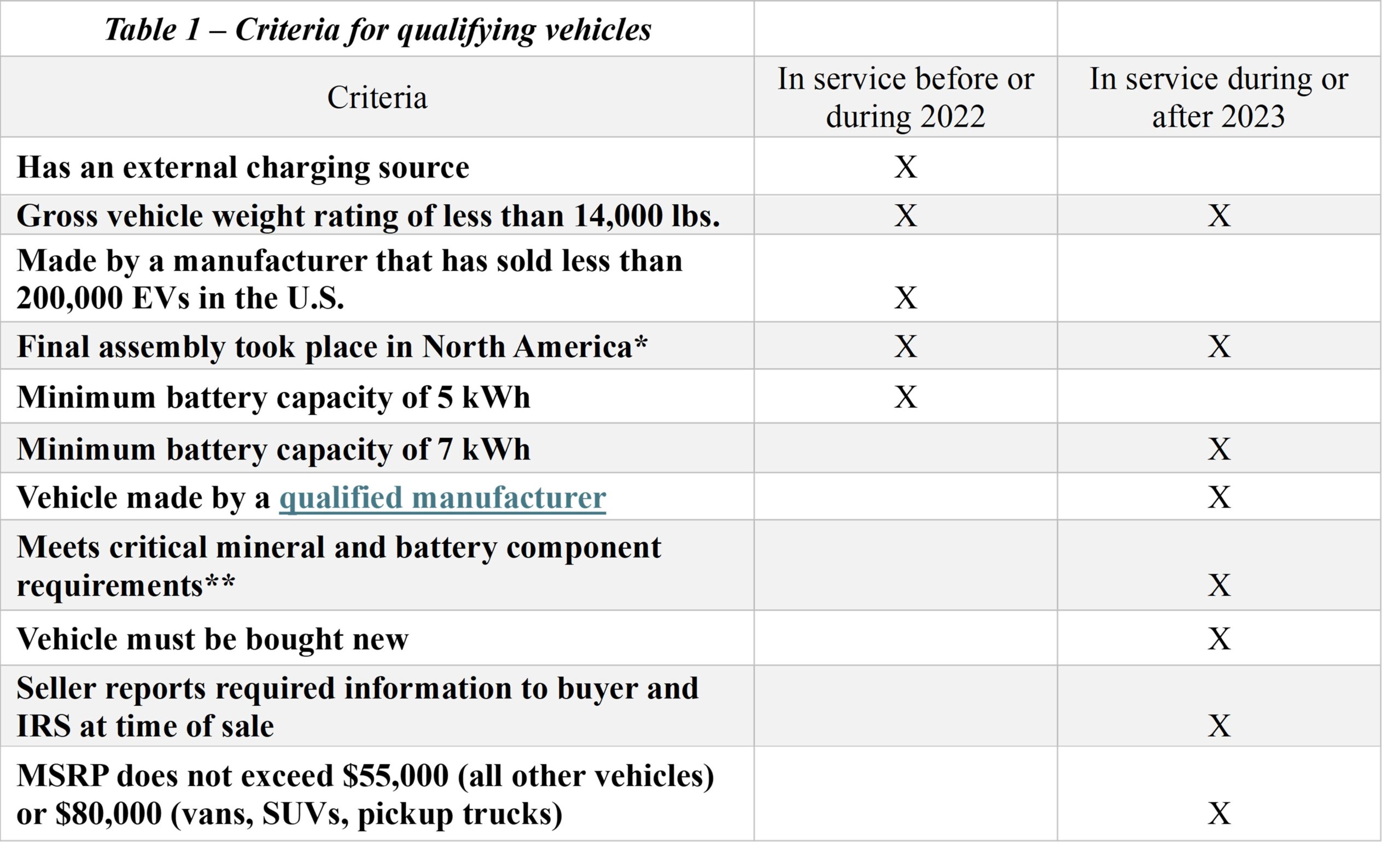Overview of the Inflation Reduction Act of 2022 and the Clean Vehicle Credit
The Inflation Reduction Act of 2022 is a 10-year plan that introduced new tax regulations and provided additional funding to the IRS. The funds were intended to improve the services and technology provided by the IRS to make the process of filing tax returns easier for taxpayers. This article will offer a brief overview of the Clean Vehicle Credit, which was implemented as part of the Inflation Reduction Act of 2022.
In both 2022 and 2023 the Clean Vehicle Credit for new vehicles may be claimed by qualifying individuals and their businesses. The vehicle must be for personal use, meaning that the credit cannot be claimed on a qualifying vehicle that was simply bought for the purpose of reselling it. The vehicle must also be used primarily in the United States. Generally, the Clean Vehicle Credit is claimed by filing Form 8936 on the tax return in the year that the vehicle was placed in service. The only time the credit may be applied as a direct reduction to the purchase price of the vehicle is if a Used Clean Vehicle Credit is being directly transferred to the seller.
Credit for vehicles purchased prior to or during 2022
The credit is equal to a base amount of $2,917 for vehicles with a minimum battery capacity of 5 kilowatt hours (kWh), plus $417 for each additional kWh of capacity over 5 kWh. The maximum credit that can be claimed is equal to the lesser of the taxpayer’s total tax liability for the year, or $7,500. Table 1 provides a summary of the criteria that vehicles must meet in order to qualify for the credit. There is no modified adjusted gross income (AGI) limitation for credits related to vehicles purchased prior to or during 2022.
Credit for vehicles purchased during or after 2023
There were a number of changes to the Clean Vehicle Credit criteria for qualifying vehicles seen in 2023. One new criterion for a vehicle to qualify for the credit is the MSRP limitation. For vans, SUVs, and pickup trucks, the MSRP cannot exceed $80,000, and for all other vehicles, the MSRP cannot exceed $55,000. The final assembly requirement is another criterion that must be met for vehicles to qualify for the Clean Vehicle Credit. This requirement was originally introduced in August of 2022, but carried over into 2023 and requires the final assembly of the vehicle to take place in North America, which further limits previously eligible vehicles. The Department of Energy website lists the vehicles that meet the final assembly requirement.
A battery capacity requirement still exists, but rather than having a minimum battery capacity of 5 kWh, vehicles must have a minimum battery capacity of 7 kWh. As of April 18, 2023, the IRS also introduced a critical mineral requirement and battery component requirement, which has an impact on which vehicles qualify, as well as the amount of credit that they are eligible for. As a result of the changes to criteria, the number of vehicles that qualify for the Clean Energy Credit has decreased. Additional criteria for qualifying vehicles are outlined in Table 1.
The amount of credit available for qualifying vehicles purchased during or after 2023 is dependent upon the date that the vehicle was placed in service. For vehicles placed in service between January 1, 2023, and April 17, 2023, the credit is equal to a base amount of $3,751 for vehicles with a minimum battery capacity of 7 kWh, plus $417 for each additional kWh of battery capacity over 7 kWh. A vehicle placed in service after April 18, 2023, that meets all existing criteria as well as the critical minerals requirement or the battery components requirement, the credit equals $3,750. A vehicle placed in service after April 18, 2023, that meets all existing criteria as well as the critical minerals requirement and the battery components requirement, the credit equals $7,500. The maximum credit is still equal to the lesser of the taxpayer’s total tax liability for the year or $7,500.
Lastly, in order for taxpayers to be able to claim a Clean Vehicle Credit on qualifying vehicles purchased during or after 2023, they must not exceed the modified AGI limitation associated with their filing status. The modified AGI limitations for each type of filer is shown in Table 2. Taxpayers have the choice of using their modified AGI in the year that the vehicle was placed in service or their modified AGI from the year prior to the vehicle being placed in service. The lower amount between the two years should be used.
Other Clean Vehicle Credits
Tax credits for used electric vehicles and commercial clean vehicles exist as well. The Used Clean Vehicle Credit can be applied to qualifying vehicles purchased for less than $25,000. The credit is equal to 30% of the selling price of the vehicle, up to $4,000. The Commercial Clean Vehicle Credit, unlike all other clean vehicle credits discussed, applies specifically to businesses and tax-exempt organizations. The maximum credit is $7,500 for vehicles weighing less than 14,000 pounds, and $40,000 for vehicles weighing over 14,000 pounds. Additional details about qualifying criteria and calculations used in determining the Commercial Clean Vehicle Credit and the Used Clean Vehicle Credit can be found on the IRS website.
*Only applies to vehicles purchased after August 16, 2022,
**Only applies to vehicles purchased after April 18, 2023
Written by Faith Reinard, Staff Accountant
Sources
- Credits for new electric vehicles purchased in 2022 or before | Internal Revenue Service
- Credits for new clean vehicles purchased in 2023 or after | Internal Revenue Service
- Used Clean Vehicle Credit | Internal Revenue Service
- Commercial Clean Vehicle Credit | Internal Revenue Service
- Inflation Reduction Act of 2022 | Internal Revenue Service
- Clean vehicle credit qualified manufacturer requirements | Internal Revenue Service
- Alternative Fuels Data Center: Electric Vehicles with Final Assembly in North America



